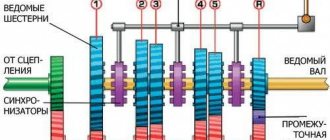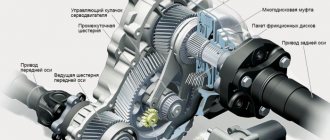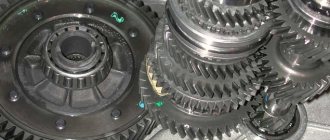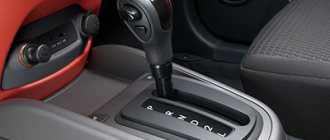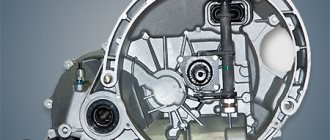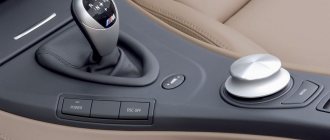Hydromechanical gearbox ⭐ consists of:
- torque converter;
- manual transmission.
In passenger cars, hydromechanical gearboxes with planetary mechanical gearboxes are most widespread. Their advantages:
- compact design;
- less metal consumption and noise;
- longer service life.
Disadvantages include:
- complexity;
- high price;
- reduced efficiency.
Gear shifting in these boxes is carried out using friction clutches and band brake mechanisms. At the same time, when one gear is engaged, some of the friction clutches and band brake mechanisms slip, which also reduces their efficiency.
The role of automatic transmission with hydromechanical control
To instantly start after pressing the gas pedal, and to protect the engine from overload, a transmission is installed in the car. It is also capable of changing torque, accelerating or decelerating the car. This transmission unit is called a gearbox - gearbox.
According to the type of gear shift, manual and automatic transmissions are distinguished:
Hydromechanical control facilitates and simplifies the driver’s work, removing some of the “responsibilities”. The smoothness and quietness of the automatic transmission increases driving comfort when starting and accelerating. The GMP also protects the engine and gearbox from dynamic loads that the driver can create by constantly “squeezing” the gas.
Main elements of a hydromechanical gearbox:
Read 5 Decent Automatic Motorcycles
Torque converter functions
A hydromechanical gearbox operates due to the movement of fluid pumped by an oil pump. The main “consumer” of oil is the torque converter (GDT). The gas turbine engine converts and transmits torque from the crankshaft to the transmission through fluid action.
Structurally, a gas turbine engine is a set of bladed wheels “locked” in a sealed donut-shaped chamber:
The hydromechanical transmission begins to work when the engine starts: the oil pump and pump wheel turn on. Liquid gets onto the wheel blades and spins around the axis of the gas turbine engine. Under the influence of centrifugal force, the oil is thrown onto the turbine blades, passes through the reactor and returns to the pump wheel. Under the pressure of the flow, the turbine blades begin to rotate, transmitting torque along the shaft to the gearbox.
The higher the engine speed, the faster the turbine wheels rotate, and the torque decreases. Without the reactor, the donut would only operate in fluid coupling mode, transmitting rotation without transformation. At the moment when the speeds of the pump and turbine are equalized, the reactor begins to rotate freely, increasing the pressure of the liquid falling on the pump blades.
Most of the engine energy is spent moving and heating the oil in the gas turbine engine. As a result, overall efficiency decreases and fuel consumption increases. To eliminate this drawback, a locking clutch with a friction lining is installed in the donut. When the clutch is engaged, the engine and transmission are firmly coupled, and torque is transmitted without loss.
The torque converter gear ratio reaches a maximum of 2.5 - 3, which is not enough for stable engine operation in different vehicle driving modes. It is not possible to engage reverse gear, since the wheels of the gas turbine engine only rotate in one direction. To compensate for these shortcomings, the hydromechanical gearbox is equipped with an additional unit.
Shifting the automatic transmission gear selector on the go
Strengths and weaknesses of fluid mechanics
The hydromechanical transmission attracts drivers with its simple controls, smooth shifting, and low price compared to CVTs or DSG. And that's not all the advantages.
| Strengths | Weak sides |
| Higher traffic safety as the driver concentrates more on the road. | Expensive to repair due to the complex design and amount of electronics. |
| Easy and quick learning to drive for beginners. | High consumption and cost of original oil. |
| Protection of the engine from overloads due to automatic gear shifting and adaptation to driving style. | With long and frequent slipping, the oil in the box overheats, so you need to avoid driving through mud. |
| The efficiency of the torque converter reaches 97% when the lock-up clutch is engaged. | The friction clutches wear out, contaminating and overheating the transmission fluid. |
| Due to the use of a reactor, the torque on the turbine wheel of the gas turbine engine increases the engine torque. This increases the service life and cross-country ability of the vehicle. | In cold weather, the hydromechanics need to warm up for a long time so that the oil comes into working condition. |
| The hydromechanical transmission has the ability to automate each unit, which makes the transmission promising. | GMT automation does not allow the driver to fully “feel” the control of the car. |
The hydromechanical gearbox will operate trouble-free for many years with regular maintenance and compliance with operating conditions.
How does a planetary gearbox work?
Its operating algorithm is extremely simple. Gear shifting on a planetary hydromechanical transmission is carried out using friction clutches. Also, to smooth out impacts when downshifting, a special brake band is used. It is when the “brake” operates that the torque transmission force decreases. But at the same time, gear shifting is smoother than that of shaft analogues.
The planetary transmission is based on a hydraulic transformer. This element is located between the engine and gearbox. HDF consists of several components:
This element is popularly called a “donut” because of its characteristic shape.
When the engine is running, the pump impeller rotates along with the flywheel. The lubricant penetrates inside the pump and then, under the influence of centrifugal force, begins to rotate the turbine. Oil from the last element penetrates into the reactor, which performs the function of smoothing out shocks and shocks, and also transmits torque. Oil circulation is carried out in a closed circle. The car's power increases as the turbine wheel rotates. Maximum torque is transmitted when the machine moves from a standstill. In this case, the reactor is in a stationary state - it is held by a coupling. When the car picks up speed, the turbine and pump speeds increase. The coupling wedges and the reactor rotates at increasing speed. When the revolutions of the last element are maximum, the torque converter will enter the clutch operating state. This way it will rotate at the same speed as the flywheel.
Planetary mechanism
In most modern automatic transmissions, the torque converter operates in tandem with a planetary system. It is responsible for transmitting torque to friction clutches. In the simplest version, the force is directed to the central gear (sun gear). Two additional satellites (auxiliary gears) are in constant mesh with the central gear thanks to the teeth applied to these elements. The satellites are not fixed, but rotate freely around their axes. The gear mechanism is located inside the crown wheel, which, depending on the gear engaged, is fixed or begins to move. At the moment the ring gear is fixed, the driven shaft begins to move (force is transmitted to it). Otherwise, the satellites transmit torque to the ring gear, leaving the driven shaft stationary. To change gears, planetary automatic transmissions are equipped with friction clutches. Each of them looks like several disks, which are thin plates of smooth metal. Each plate is coated with a special friction compound that prevents wear. On some of them you can find slots. Gaskets are located between the couplings. They are pressed against each other using a hydraulic piston that operates by supplying working fluid. As the pressure in it increases, the clutches close tightly, becoming almost a single whole. After the fluid pressure in the hydraulic piston drops, the friction discs return to their place using a spring. The operation of friction clutches is closely related to the functioning of brake and planetary mechanisms. At these moments, commands from the gearbox control system and engine torque are transmitted. Without their participation, engine braking and towing launching are not possible. The mechanical unit operates smoothly and clearly.
planetary system
Important! In the neutral position, the clutches and brakes are turned off. When accelerating and changing gears, the clutches begin to operate, and the planetary systems rotate synchronously.
Fluid mechanics design
GMFs use simple step or planetary mechanisms with electronic control. The principle of operation of the hydromechanical gearbox in both versions is to change the rotation speed of the output shaft due to different gear ratios.
How does a shaft gearbox work?
The design of a shaft-type hydromechanical gearbox is similar to a manual gearbox. Torque conversion occurs in steps through the inclusion and disengagement of gears located on parallel shafts. The number and size of gear pairs correspond to a certain gear ratio.
The primary, input shaft receives torque from the torque converter. Through a pair of permanently meshed gears, power is transmitted to the output shaft and then to the wheels. To obtain direct transmission, an intermediate shaft is added to the design, and the primary and secondary shafts are placed on the same axis.
To expand the speed range, multi-shaft designs with 4 or more shafts are used. At the same time, the operation of the box becomes more complicated, its dimensions and weight increase. Similar GMPs are found on tractor-trailers.
Gear drives are controlled by friction multi-plate clutches. The clutch becomes a brake when connected to the GMT housing. To engage the locking, the oil pump supplies hydraulic pressure to the clutches. Thanks to the clutches, the speed switches smoothly, and the use of a hydraulic drive speeds up braking.
Shaft-type hydromechanical gearboxes do not cope well with the growing thrust from increasing vehicle load capacity and tightening requirements for fuel efficiency. An increase in parameters significantly increases the weight and dimensions of the structure. For these reasons, shaft gearboxes are replaced with planetary gears.
How does a planetary gearbox work?
Engineers prefer to install a planetary mechanism in a hydromechanical gearbox instead of a stepped design for the following reasons:
Automatic transmission reset, calibration and adaptation
A simple planetary gear consists of central gears: with internal teeth - the crown, with external teeth - the sun. Between them, satellite gears are rolled, the axes of which are fixed to the carrier frame. Depending on the design, the carrier is connected to the output shaft or ring gear.
The design of the planetary gearbox determines its operating principle. To change the torque of the torque converter, one of the elements of the planetary gear is rotated, and the other element is braked. The third element becomes the driven element, and its speed is determined by the number of teeth of all gears.
To achieve direct transmission, the carrier and sun gear are rigidly connected. The crown cannot rotate relative to the fixed system, so the mechanism rotates as a single unit. The gear ratio in this case is 1.
To obtain reverse gears, the central gears rotate in one direction. To do this, stop the satellites, blocking the carrier.
Brake bands or friction discs are used as planetary gearbox brakes. The locking elements operate automatically based on an electronic signal.
Electronically controlled automatic transmission
As an example of a modern automatic transmission with electronic control, consider the six-speed gearbox 09G from the Japanese concern AISIN.
The automatic transmission consists of a torque converter, a mechanical planetary gearbox with multi-disc clutches and multi-disc brakes, a hydraulic system, cooling and lubrication systems, and an electrical system.
Rice. Section of the automatic six-speed gearbox 09G: K – multi-plate clutches; B – multi-disc brakes; S – sun gears; P – satellites; RT – carrier; F – overrunning clutch; 1 – turbine wheel shaft; 2 – driven gear of intermediate gear; 3 – liquid pump
The planetary series are combined according to a scheme developed by Lepelletier. The engine torque is supplied to a single planetary gear set. Next it goes to the Ravigneaux dual planetary gearset.
Rice. Lepelletier two-gear planetary system: a – conventional planetary gearbox; b – Raviño planetary gearbox; 1 – turbine wheel shaft; P1 – satellite ring gear H1; P2 – satellite of sun gear 2; P3 – satellite ring gear 1; S1 – sun gear 1; S2 - sun gear 2; S3 - sun gear 3; H1 – ring gear 1; H2 – ring gear 2
The single planetary gear set is controlled by multi-disc clutches K1 and K3 and multi-disc brake B1. The number of satellites in the planetary gears is selected depending on the transmitted torque.
The twin planetary gear set is controlled by a multi-disc clutch K2, a multi-disc brake B2 and an overrunning clutch F. The clutch control system includes dynamic pressure compensation devices that make the clutches operate independently of the rotation speed. Clutches K1, K2 and K3 serve to supply torque to the planetary gears, and with the help of brakes B1 and B2, as well as the overrunning clutch, the reactive torques are transmitted to the gearbox housing.
The pressure in the clutch and brake working cylinders is changed by control valves.
Overrunning clutch F is a mechanism that operates in parallel with the brake.
Types of fluid mechanics
For a long time, automatic transmissions were installed exclusively on middle-class and premium cars. Today, the unit has received widespread use and is becoming increasingly popular among car enthusiasts. Automatic transmissions can significantly increase comfort while driving, but it is worth considering that such units differ in types, each of which has its own advantages and disadvantages. Having understood the principle of operation of hydromechanical transmissions, it will be possible to decide which type of automatic transmission is suitable for a particular driver. It is worth mentioning the following types of hydromechanical gearboxes:
Robotic units and automatic transmissions are devices whose purpose is to simplify the driver’s interaction with the transmission.
Purpose of a combined transmission of a passenger car
The lifestyle of modern drivers is changing significantly and today more and more demands are placed on creating optimal comfortable conditions while driving. Standard car components are undergoing significant changes; among the most striking examples are the combination of mechanical and hydraulic gearboxes. If we talk about hydromechanical transmission and what it is, the first step is to understand what its purpose is. The main difference is the smooth change in rotational motion. Lighter control made it possible to abandon the use of a clutch, since the combined gearbox is responsible for all processes. With automatic transmission, we can talk about the following situations regarding driving a car:
- When changing gears, the transmission is disconnected from the power unit.
- If road conditions change, the amount of torque will also change.
Using an automatic transmission in a car allows you to get several undeniable advantages. In addition to the automation of gear shifting, it is also worth noting the increased performance characteristics of the power unit and gearbox and the improved cross-country ability of the vehicle in off-road conditions.
Automatic hydraulic box
Electronic part of hydromechanical automatic transmission
In a hydromechanical automatic transmission there is no clutch, so each gearbox stage is equipped with a switching element. The operation of the elements is controlled by an electronic computer unit connected to the engine control unit. During gear changes, the engine speed is automatically adjusted, which helps to achieve optimal performance of the unit.
The electronic control system of the hydromechanical transmission is divided into subsystems:
To automate control, in addition to the computer, the system includes electric valves, sensors, amplifiers, regulators, corrective elements, etc. Electrovalves - solenoids, are located in the valve body, and upon a signal from the ECU, they open the hydraulic plate channel for the passage of fluid to the clutches, torque converter and other components.
Depending on the position of the selector, the ECU operates according to a software algorithm stored in memory:
Which is better and more reliable, CVT or automatic?
“Smart” control conducts self-diagnosis to correct the operation of the GMF. For example, if the oil in the box is dirty, then the pressure in the system drops. To protect components, the ECU can block gear shifting, redistribute the load between electric valves, and prohibit the inclusion of the torque converter. The computer records malfunctions and failures in the box in the form of codes.
The computer can adapt, choosing the appropriate mode for the driving style, acceleration dynamics and braking style. Adaptation reduces gearbox wear by reducing the number of switchings. This increases driver comfort and traffic safety.
Features of the hydromechanical unit
Cars around the world have used manual transmissions for a large number of years. In order to use it, drivers constantly had to perform the following actions:
- turning off the vehicle’s internal combustion engine at the time of switching;
- moving the gearshift lever to the desired position;
- return of the connection between the internal combustion engine and the wheels.
Over time, the situation has changed a little, as engineers developed a hydromechanical transmission system. It greatly facilitates the process of driving a car, since it does not require the driver to change gears independently. Instead, this is done by special automatic devices.
A hydromechanical transmission requires the motorist to use only three elements , such as:
- gas pedal;
- brake pedal;
- gear selector.
In order to move away, the person behind the wheel needs to depress the brake pedal, move the selector to position D (Drive), release the brake pedal and start driving. In the future, between gears, the automatic transmission will independently adjust itself by analyzing the speed of the vehicle, the position of the gas pedal, engine speed and many other factors.
Thus, the design of the hydromechanical transmission has certain changes . This mechanism includes the following elements:
- Torque converter . It works in the same way as a clutch - it transmits rotation from a running power unit to the automatic transmission.
- ECU, that is, an electronic control unit. It receives information from control sensors, analyzes it and makes a decision on the need to change the transmission automatically.
- Friction elements . They are used to change gears at the right time. A distinctive feature of these discs is that they are constantly impregnated with oil. As a result, these elements have a long service life, almost without wearing out during operation.
- Pump. Its main purpose is to create oil pressure.
- Springs and channels. They are used in a hydromechanical system to interact with all other structural parts in it.
- Mechanical box. As in a standard gearbox, this mechanism is necessarily present in the automatic transmission, being its basis.
Thus, nowadays, due to the greater convenience of the hydromechanical transmission, it is becoming increasingly popular around the world.
Prospects for using a hydromechanical gearbox
The hydromechanical gearbox is constantly being improved:
A hydromechanical gearbox with a planetary mechanism has great promise. The transmission is suitable for low-power and heavy-duty engines by adding new planetary gears and varying gear ratios. New technical solutions increase vehicle efficiency. Adding steps eliminates “dips” in gear shifting, achieving maximum smoothness.
Manufacturers produce HMFs of different sizes for engine power from 50 to 1500 kW. As the load capacity of special equipment increases, the efficiency and traction characteristics of the transmission increase.
The development of intelligent automated control and diagnostic systems is aimed at increasing vehicle efficiency and ensuring driver safety. The hydromechanical gearbox is adapted for automation, which opens up great opportunities for expanding the functionality of mechanisms and systems.
Source
Hydromechanical gearbox: operating principle and design
The classic design of a car implies the presence of two required blocks:
This description is suitable for a manual transmission that has been familiar to motorists for many decades. But over time, as technology developed, other variations of the gearbox unit began to appear, providing the person behind the wheel with greater comfort of movement.
Transmission is one of the basic components of a car. Thanks to it, torque is transmitted from the car engine to the wheels. In the automotive industry, for many years the manual transmission reigned supreme, incorporating the blocks described above in its design. The driver had to perform three sequential operations:
But the situation has changed, engineers have created a gearbox without a clutch pedal. In this case, the process of driving a car is greatly simplified for a person: the ECU makes the transition to the desired gear itself. Control is carried out by the gearbox selector, brake and gas pedals.
When moving away, the driver depresses the brake, moves the selector to position D (Drive), releases the brake, and starts driving. The automatic transmission shifts to 1st gear, 2nd and beyond, depending on the speed of the car, the position of the gas pedal, engine speed and other factors, which are monitored by a variety of sensors.
This process is ensured by the use of several technologies, the hydromechanical gearbox among which is the most famous, “tested” in production and reliable. In it, changing gears on clutches is carried out by circulating transmission oil under pressure through the box.
A modern hydromechanical transmission is a complex device consisting of the following main components:
The latter is not a typo; the automatic transmission is really based on “mechanics”, structurally supplemented by automatic switching units with a torque converter - hence the name of the unit. Cross-section of a typical hydromechanical gearbox:
The history of the automatic transmission began in the first quarter of the 20th century: then the Ford concern began to introduce the first examples of “hydromechanics” into its products. In the USSR, automatic transmissions did not become widespread among the end consumer, although, for example, at the end of the 50s, the LAZ plant, in collaboration with NAMI, developed and implemented a hydromechanical transmission in buses of the LAZ-695Zh series. Later it was used in the LiAZ-677 model; about 200 thousand buses with automatic transmission were produced.
Hydromechanics of LAZ in section:
In the modern automotive industry, “automatic” is very common, even in budget car models.
Hydromechanical transmission of a car, purpose and device
Integral elements of the design of a classic car are the clutch and gearbox. But the changing lifestyle dictates the creation of optimal comfort for drivers. This leads to changes in the standard components of the car. They are increasingly being replaced by a combined hydromechanical transmission, which includes both mechanical and hydraulic transmissions. In devices of this type, the gear ratio and torque change gradually and smoothly.
Transmission
The role of transmission in a car
For a vehicle, the transmission is anything that produces torque from the engine to the wheels, such as a transmission with a clutch, as in classic cars. Today in cars they are being replaced by automatic transmission, when control is easier, a clutch is not provided, and shifts are made automatically. These processes are carried out by a hydromechanical gearbox. To understand the process, you need to know about two main issues that arise when driving a car:
- When changing gears, the transmission is disconnected from the engine;
- After changing road conditions, the torque value is changed.
This happens after the clutch is depressed and the gearbox changes speed (in conventional cars). In vehicles with automatic transmission, these processes are in most cases carried out by a hydromechanical gearbox.
Hydromechanical box mechanism
The automatic transmission used in passenger cars includes:
- Torque converter;
- Control components;
- Manual gearbox.
- The engine and torque converter connect the pump;
- Provides connection to the turbine input shaft;
- Strengthens reactor torque.
Torque converter
Torque converter A modern automatic transmission includes a torque converter, which performs clutch functions in a car with a gearbox (supplies torque). Thanks to the torque converter, the vehicle moves off smoothly. Reducing dynamic loads in the transmission leads to increased durability of the engine, as well as other transmission mechanisms. Reducing the number of gear changes reduces driver fatigue. The use of a torque converter significantly increases the vehicle's maneuverability on sand and snow.
It creates a stable traction force with a very low rotation speed on the drive wheels, which increases their grip on the road surface.
It turns out that the use of automatic transmissions is recommended on SUVs. The torque converter has a fairly simple device and combines three wheels:
Turbines are 3/4 placed in oil and protected by a special housing. The working process of a hydromechanical drive is based on the fact that torque is directed from the engine to the pump wheel, and an oil flow is supplied to the turbine wheel. It spins the wheel, and the force is transferred to the gearbox shaft. The entire oil circulation process follows a special trajectory: from the outside of the pump ring it is directed to the turbine ring, and then back through the center of the mechanism to the pump ring. Turbine The torque converter automatically changes the torque as the load increases, then it is transmitted to the manual transmission, and the gears are switched by friction devices.
The hydraulic drive determines the sufficient gear ratio by changing the pressure of the fluid to circulate it between the pressure disc and the turbine.
The torque converter performs its work directly with the planetary gearbox.
Planetary box
In hydromechanical automatic transmissions, a planetary mechanism is more often used. In its simplest design, torque is supplied to the sun gear. Freely rotating satellite gears are constantly engaged with it. They have a carrier connected to the shaft. If the ring gear is in the braked position, then the torque is directed through the carrier to the driven shaft. If the gear is released, then the satellites supply torque to it. The driven shaft is stationary.
Advantages and disadvantages of an automatic transmission
Pros of automatic transmission:
- No manual gear shifting;
- Ensures uniform power delivery.
Cars with automatic gear shifting are particularly smooth. When the driver does not need to shift manually, the process of driving a vehicle is simplified. The disadvantages are the more complex design of transmissions and their large mass. The disadvantages include lower efficiency, which reduces the fuel efficiency of the vehicle. This is the simplest version of a hydromechanical transmission, and today more advanced models are installed on passenger cars.
About the torque converter
The heart of the type of box under consideration is a unit called a torque converter. Its device can be seen in the diagram:
The unit is located between the mechanical part of the gearbox and the engine, and serves as a clutch. The use of a torque converter allows, in addition to the convenience of the driver, to give the vehicle smooth starting and stopping, and to ensure movement without jerking. This directly affects the durability of the engine, since the dynamic loads that are inevitable when operating a car manually are significantly reduced.
Structurally, this unit is made up of disks with blades connected to each other:
Interesting: the entire disk unit is united by one casing, three-quarters immersed in transmission oil, which is the main operating medium of the automatic transmission.
The pump wheel rotates synchronously with the flywheel, at a similar speed. When rotation occurs, transmission oil flows to the turbine wheel, transmitting the rotational force to the latter. The oil then goes to the reactor wheel, which moves the liquid back to the original pump wheel. Thanks to the process of circulation of the working fluid under pressure, torque is transmitted to the wheels.
Interesting: the unit automatically determines the required gear ratio and transmits force to the automatic transmission, and the box already engages the desired gear using the clutches.
In addition to passenger vehicles, torque converters are used in heavy equipment: some models of shunting diesel locomotives and locomotives, diesel tractors, tractors, and cranes. A similar device drove the propellers of the tugboat Marshal Blucher. The Chaika, Volga, and ZIL cars equipped with a hydrodynamic transmission were also equipped with torque converters.
There are types of hydromechanical automatic transmission:
Torque converter device
You can understand what a hydromechanical transmission device is by studying its design. The main components are the torque converter, manual gearbox and control mechanisms. The torque converter is the main component, and it performs almost the same function as the clutch. Having studied the design of this part, you can see that it consists of three wheels that have a special shape. The first wheel is a pump wheel, its purpose is to communicate between the hydraulic unit and the power unit. The second ring is a turbine ring; it forms a connection with the input shaft of the box. The third wheel is a reactor wheel, its function is to increase torque. All three components are closed by means of a special housing, the internal volume of which is three-quarters filled with lubricant. From the engine, torque is supplied to the pump part, then, through rotational movements, it directs lubricant to the turbine wheel, as a result of which the force is transmitted to the input shaft. As the load increases, the torque converter will automatically change the torque, which in turn, transmitted to the mechanical components, will be switched through friction components. The fluid pressure passing from the pressure disk to the turbine is also regulated automatically.
How does a shaft gearbox work?
Shaft automatic machines are quite widely used in the production of buses and heavy-duty vehicles. The word “shaft” refers to the manual transmission in an automatic transmission. The “mechanical” unit happens in this case:
To change gears, multi-plate clutches immersed in a special oil are used, and reverse gear, the first stage of the transmission, is in some cases engaged by a gear clutch. The design of such automatic transmissions allows you to switch speeds using clutches due to the operation of the crankshaft, without loss of power or loss of torque.
The classic design is two-shaft, with a primary (drive) and secondary (driven) shaft carrying gears. In the three-shaft scheme there is also an intermediate shaft, where the gear connected to the main gear is located.
Shaft models have found limited use in passenger cars: in particular, many Honda cars and a number of Mercedes models are equipped with them. The use of such gearboxes is associated with certain technical difficulties: on rear-wheel drive vehicles, an alignment requirement is applied to the gearbox, and the shaft automatic transmission must have at least two gears per gear. And this reduces efficiency.
Another disadvantage is high disk losses if the vehicle has more than three gears. In this case, there are many disengaged clutches in the shaft box, which leads to the indicated losses. In addition, the shafts are quite large in length, which makes the box bulky and reduces free space in the cabin, as well as increases noise and reduces reliability. This was partly solved by the introduction of three-shaft boxes, with shorter, stiffer and more reliable shafts.
Machine breakdowns
Most breakdowns in both classic automatic transmissions and CVTs occur due to untimely maintenance or improper operation of the vehicle. At the same time, the machine has characteristic weaknesses:
- contamination of the valve body as a result of poor quality transmission fluid;
- decrease in oil pressure due to a malfunction of the oil pump;
- scrolling clutches on discs;
- jerking of the car when changing the gear ratio;
- wear of planetary gears;
- disturbances in the operation of sensors;
- wear of friction linings.
There are still breakdowns. characteristic of specific car models. They usually arise due to engineering miscalculations when designing the machine. This problem is most acute among domestic iron horses.
How does a planetary gearbox work?
For hydromechanical transmissions, manufacturers try to use a planetary mechanism:
In general, the design and operating principle of a hydromechanical gearbox created on the basis of a planetary system can be described as follows:
The carrier, when the ring gear is stationary, transmits force to the driven shaft; when it is released, the force goes through the satellites to gear number 2. The shaft itself remains motionless. Direct switching occurs through belt mechanisms and friction clutch packages.
Pros and cons of fluid mechanics
Summarizing what has been said, we can conclude: a hydromechanical automatic transmission is a unit consisting of a torque converter, a manual transmission module (in most cases planetary), equipped with a clutch pack, a hydraulic control system and a control electronic unit.
The advantages of this combination:
But there are also obvious disadvantages. One of them is relatively low efficiency compared to mechanics, which is due to the presence of a torque converter.
Important: during the circulation of the working fluid, part of the efficiency is lost: according to research, the efficiency of a manual transmission is about 98%, the same figure for an automatic transmission is in the range of 86-90%.
In addition, there are other disadvantages:
But the advantages of hydromechanical gear shifting still outweigh its disadvantages, especially for novice drivers who do not have sufficient experience. In addition, in the urban rhythm of traffic, with constant traffic jams, a hydromechanical automatic transmission saves both the strength and nerves of the driver, who does not have to perform endless “clutch-transmission” manipulations and drive at 1st speed with the clutch half depressed.
Source
